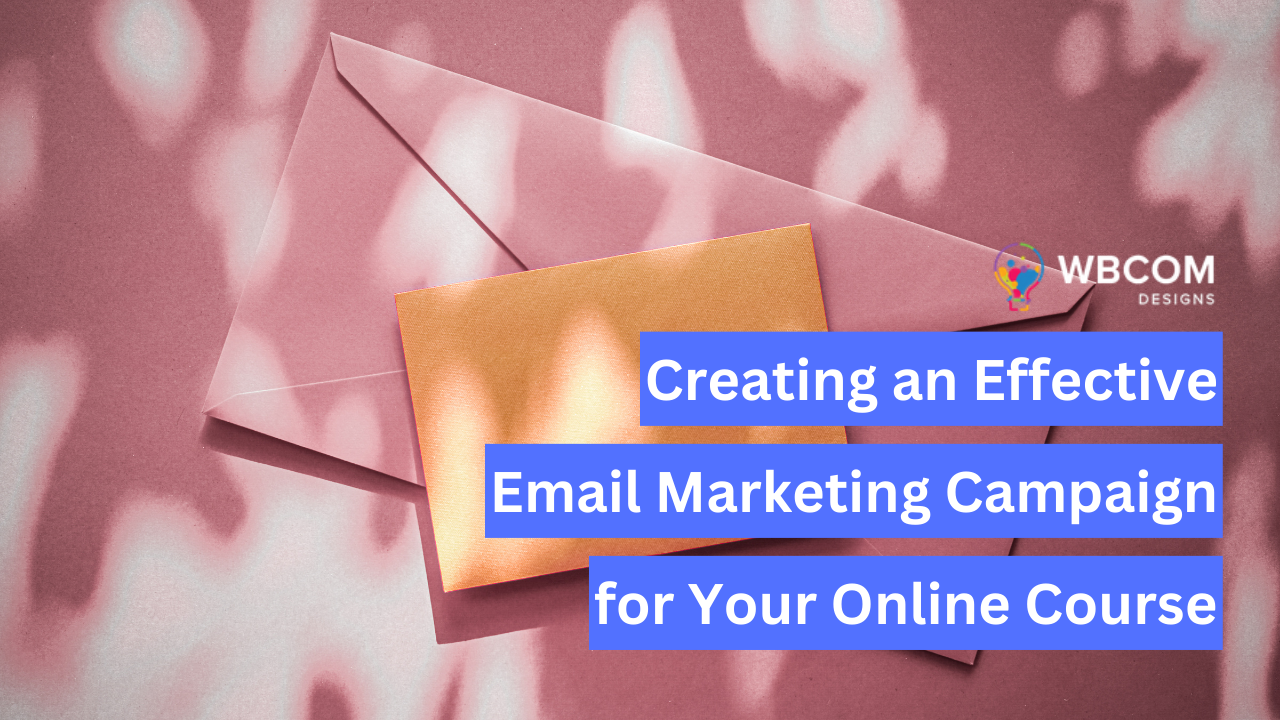Are you struggling to attract new students to your online course? Or maybe you have a decent number of students, but you’re having trouble keeping them engaged and motivated to continue learning. If so, you’re not alone. Many course creators face similar challenges in marketing and promoting their courses. But fear not because email marketing is a powerful tool that can help you overcome these obstacles and succeed. In this blog post, we’ll explore how to create an effective email marketing campaign for your online course that will help you attract, engage, and retain your students. So please grab a cup of coffee, get comfortable, and let’s dive in!
Table of Contents
ToggleBuilding an Email List
Email marketing is a powerful tool that allows you to communicate directly with your audience and build customer relationships. But you need a strong email list to make the most of this marketing channel. Whether starting from scratch or looking to grow an existing email list, you can use several tips and techniques to build a high-quality checklist and make the most of your email marketing campaigns.
Tips for Building an Email List from Scratch
- Offer something of value: People are more likely to provide their email addresses if they feel they are getting something of value in return. Consider offering a free guide, discount, or another incentive for signing up for your email list.
- Make it easy to sign up: Place sign-up forms on your website, social media pages, and other online platforms where your audience will likely see them. Make the process as simple as possible, with just a few fields for users to fill out.
- Use social proof: Social proof can motivate people to join your engaged email list. Include testimonials from satisfied customers or display the number of subscribers you have to encourage others to sign up.
Techniques for Growing an Existing Email List
- Create targeted content: Develop content that resonates with your audience and includes a clear call-to-action to join your email list. Share this content on your website, social media pages, and other platforms to attract new subscribers.
- Host a giveaway: Offer a prize or giveaway to anyone who signs up for your email list. This can be a great way to generate excitement and attract new subscribers.
- Use pop-ups: While pop-ups can be annoying, they can also effectively capture visitors’ attention to your website or landing page. Use them strategically and consider offering an incentive for signing up.
Best Practices for Managing and Segmenting Your Email List
- Segment your list: Segmenting your email list allows you to send targeted messages to specific groups of subscribers based on their interests or behaviors. This can help increase engagement and conversion rates.
- Keep your list clean: Regularly remove inactive or unsubscribed subscribers to keep your list up-to-date and improve deliverability rates.
- Personalize your messages: Use data from your subscribers to personalize your messages and make them more relevant. This can help increase engagement and drive conversions.
Crafting Effective Emails
Email marketing can be a powerful tool for businesses to connect with customers and promote their products or services. However, with inboxes flooded with countless emails daily, crafting compelling email content that stands out and engages your audience is essential. Here are some tips and techniques to help you create attention-grabbing subject lines, persuasive email copy, and best practices for email design.
Importance of Crafting Effective Email Content
Effective email content can distinguish between a successful email campaign and one that falls flat. Your content should be engaging, relevant, and focused on the needs and interests of your audience. It should also have a clear call-to-action that encourages readers to act, such as purchasing or signing up for a newsletter.
Tips for Creating Attention-Grabbing Subject Lines
- Keep it short and sweet: The best subject lines are short and to the point, with no more than 50 characters.
- Use personalization: Including the recipient’s name or other personal details can make the email feel more personalized and increase the likelihood of it being opened.
- Create urgency: Use language that creates a sense of urgency, such as “limited time offer” or “don’t miss out.”
Techniques for Writing Compelling Email Copy
- Be concise: People are busy and don’t have time to read long emails. Keep your copy short and to the point.
- Focus on benefits: Highlight the benefits of your product or service rather than just listing features.
- Use a conversational tone: Write as if conversing with the recipient rather than sounding like a salesperson.
Design Best Practices for Email Marketing
- Use a clean layout: Keep your email design clean and simple, with plenty of white space and clear calls to action.
- Use images wisely: Use pictures to support your message, but avoid overloading your email with too many graphics.
- Make it mobile-friendly: Most people check their email on their smartphones, so make sure your email is optimized for mobile viewing.
Automation and Sequences
Email marketing, automation, and email sequences can be powerful tools for promoting your online course. But what exactly are automation and sequences, and how can they benefit your email marketing efforts?
Automation refers to using software and technology to automatically send emails to your subscribers based on specific triggers or actions. For example, you may set up an automation to send a welcome email to new subscribers or a follow-up email to those who have abandoned their cart.
Conversely, email sequences are emails sent over a set period, usually to nurture leads and convert them into customers. For example, you may create emails introducing your online course, providing valuable content related to the course topic, and end with a call-to-action to enroll.
The benefits of using automated emails and sequences for course promotion include the following:
- Saves time and effort: By automating your email marketing efforts, you can save time and focus on other essential aspects of your business.
- Consistent messaging: Email sequences ensure your messaging is consistent and on-brand, which can help build trust with your audience.
- Increased engagement: Automated emails and sequences can help keep your subscribers engaged with your brand, even if they don’t purchase immediately.
Tips for Setting up Effective Email Sequences
- Define your goals: Before creating an email sequence, it’s essential to define your goals and determine what actions you want your subscribers to take.
- Segment your list: Segmenting your email list allows you to send more targeted and personalized emails, which can lead to higher engagement and conversions.
- Use a mix of content: Your email sequence should include a mix of content, including educational content, promotional offers, and calls to action.
- Test and refine: As with any marketing campaign, it’s essential to test and refine your email sequences to ensure they are effective.
Personalization and Segmentation
In today’s digital age, email marketing is essential for businesses to connect with customers and promote their products or services. However, with inboxes flooded with countless emails daily, it’s important to personalize and segment your email content to stand out and engage your audience. Here are some tips and techniques to help you personalize and segment your email marketing efforts.
Importance of Personalization and Segmentation in Email Marketing
Personalization and segmentation can significantly increase the effectiveness of your email marketing campaigns. By segmenting your email list based on characteristics such as location, interests, or purchase history, you can create more targeted and relevant content that resonates with your audience. Personalization can also help build stronger relationships with your subscribers, showing that you understand their needs and preferences.
Techniques for Segmenting Your Email List
- Demographic segmentation: Segment your email list based on characteristics such as age, gender, income, or occupation.
- Geographic segmentation: Segment your email list based on location, city, state, or country.
- Behavioral segmentation: Segment your email list based on subscriber behavior, such as purchase history or website activity.
Tips for Personalizing Email Content
- Use the subscriber’s name: Addressing the subscriber by name is a simple but effective way to personalize your email content.
- Use dynamic content: Use dynamic content to tailor your email content to the subscriber’s interests or behavior.
- Use personalized subject lines: Personalized subject lines can significantly increase open rates and engagement.
- Use a conversational tone: Write your email content in a conversational tone, as if you’re speaking directly to the subscriber.
Testing and Optimization
In the world of email marketing, testing, and optimization are crucial to ensuring the success of your campaigns. You can continually test and optimize your email content to improve your subscribers’ open rates, click-through rates, and overall engagement. Here are some tips and techniques for testing and optimizing your email campaigns.
Importance of Testing and Optimizing Email Campaigns
Testing and optimizing your email campaigns is essential because it allows you to identify what works and what doesn’t and make data-driven decisions to improve the effectiveness of your campaigns. By testing different variables, such as subject lines, content, and call-to-actions, you can determine what resonates best with your audience and improve the overall performance of your email campaigns.
Techniques for A/B Testing Email Subject Lines and Content
- Test one variable at a time: When conducting A/B tests, it’s important to test one variable at a time to determine each change’s impact accurately.
- Define your goals: Before conducting any tests, it’s essential to define your goals and determine what metrics you want to improve.
- Test a small sample size: When testing, start with a small sample size to minimize the impact on your overall email list.
- Test frequently: Testing frequently allows you to improve your email campaigns’ effectiveness continually.
Tips for Analyzing and Improving Email Campaign Performance
- Use analytics tools: Use analytics tools to track key metrics such as open rates, click-through rates, and conversion rates.
- Analyze your results: Analyze the results of your A/B tests to determine what worked best and what didn’t, and use this information to optimize future campaigns.
- Continuously improve: Test and optimize your email campaigns to improve their effectiveness over time.
- Use personalization and segmentation: Use personalization and segmentation techniques to create more targeted and relevant content for your subscribers.
Wrapping Up Words
Email marketing can be a powerful tool to promote your online course and increase enrollment. Following the tips outlined in this article can create an effective campaign that will engage your audience and drive conversions. Remember to focus on providing value, segmenting your audience, and testing and optimizing your emails for maximum impact. With a little effort and creativity, you can take your online course to the next level and reach more students than ever!








